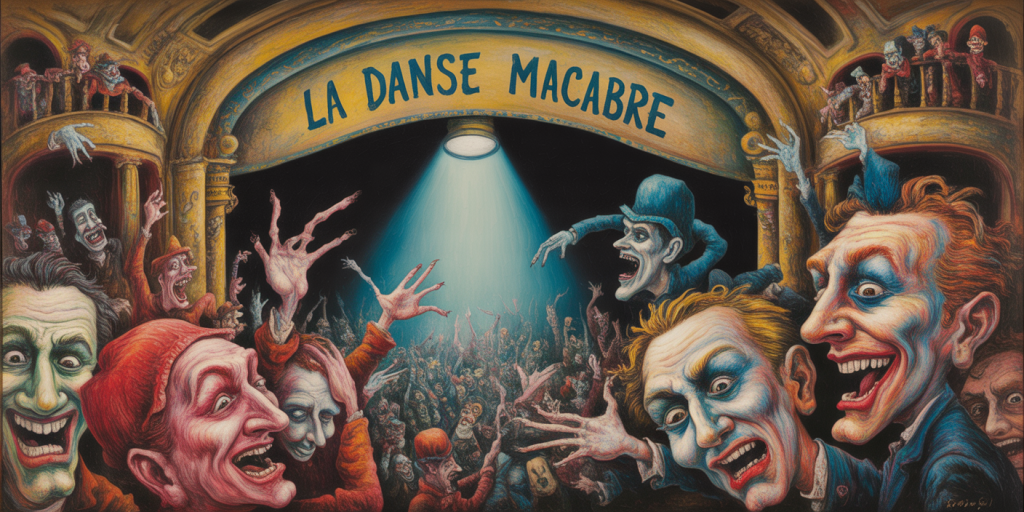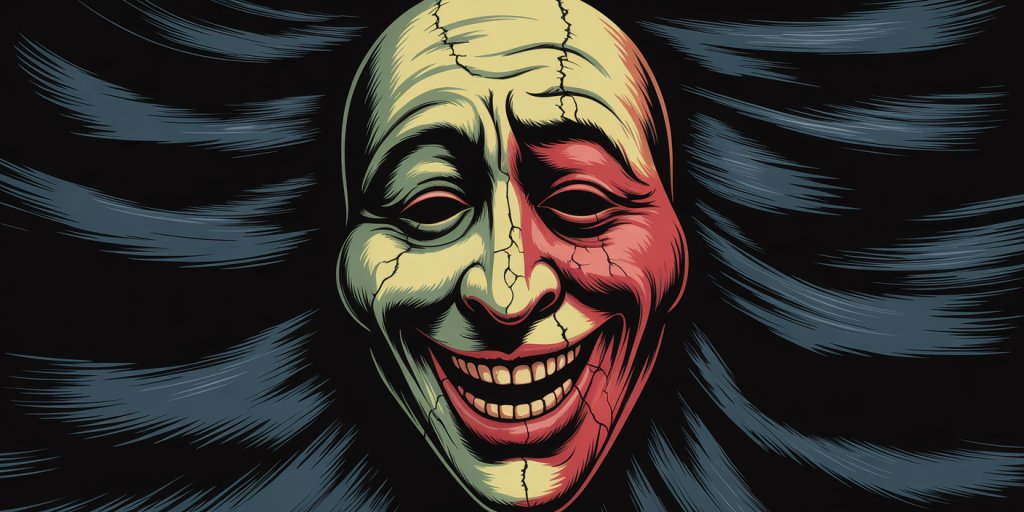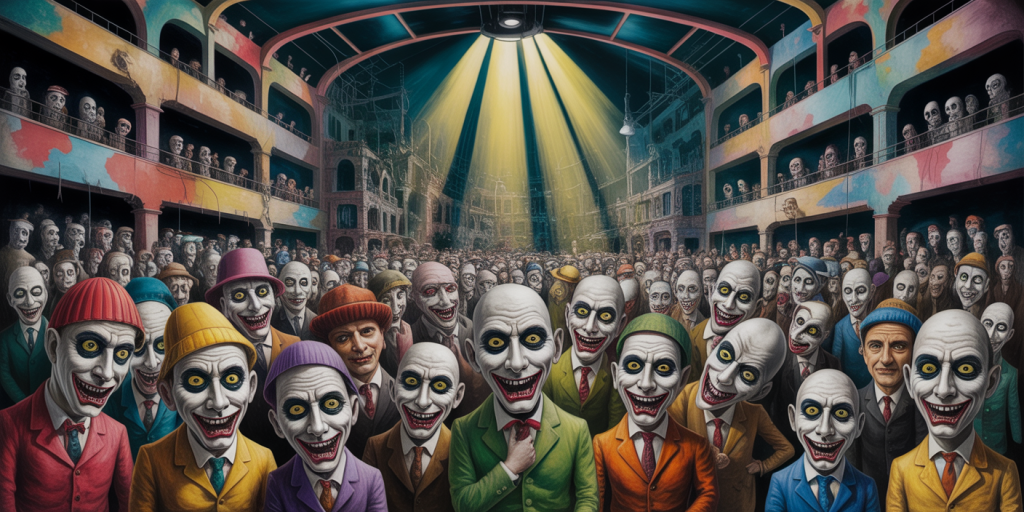Ensor’s Mask and the Tragic Theater of Identity
There are canvases that do not depict a face, but unmask the very idea of one. In James Ensor’s haunted theaters of pigment, identity sheds its skin to reveal not truth, but performance. The mask in his universe is not concealment—it is revelation. In the grotesque crowd of distorted smiles and glassy stares, we see not caricature but confession. Each face painted is a mask worn by the soul, struggling to define itself in a carnival of falsity.
To step into Ensor’s world is to enter a pageant of the uncanny, where light flickers like stage fire, and identity becomes a theatrical script constantly rewritten. Color clowns with chaos. Shadows hiss like stage whispers. This is not merely satire—it is a tragic theater of being, where the self becomes a character lost in its own masquerade.
Table of Contents
- The Carnival of Lost Faces
- The Carnival of Lost Faces
- The Stage of Screaming Silhouettes
- Color as Grotesque Confession
- Anatomy of a Paper Smile
- Eyes that Belong to No One
- The Theater of Death and Delight
- Faces Split by Laughter and Fear
- The Mirror Wears a Mask
- Flesh Beneath Painted Skin
- Commedia dell’Arte of the Psyche
- Lights That Burn with Satire
- The Body That Dissolves in Costume
- The Crowd That Swallows the Self
- When Identity Becomes Costume
- The Tragic Wisdom of the Buffoon
- The Portrait as Farce
- Canvas as Proscenium
- Spectacle of the Subconscious
- The Curtain That Never Falls
The Carnival of Lost Faces
Ensor populates his world with faces that no longer belong to anyone. They hover, leer, grin without sincerity, grotesque parodies of humanity—and yet, disturbingly intimate. These are not strangers; they are fragments of ourselves disassembled and reborn in absurdity.
When Masks Speak Louder Than Flesh
In Ensor’s universe, the mask holds more truth than the face it hides. Painted with aggressive color and haunted by fixed expressions, they reveal emotional undercurrents too intense for bare skin. Identity becomes theatrical—a mask that confesses through performance.

The Stage of Screaming Silhouettes
His scenes are arenas, stages upon which inner torment is broadcast in grotesque pantomime. Silhouettes screech, bodies bend unnaturally, and space collapses under emotional pressure. The backdrop is rarely still; it trembles with psychodrama.
Color as Grotesque Confession
Ensor’s palette is jarring, deliberately offensive. It does not soothe—it provokes. Sickly yellows, bleeding reds, bruised greens swarm the canvas like feverish hallucinations. Each hue performs an emotion: disgust, satire, hysteria, ecstasy.
Anatomy of a Paper Smile
The smiles of Ensor’s masks are anatomical impossibilities. They stretch too far, curve unnaturally, and tremble with false mirth. These paper grins become metaphors for emotional dissonance—the struggle to perform normality when madness lurks beneath.
Eyes that Belong to No One
The eyes of Ensor’s figures are often vacant or doubled, glazed or gouged. They do not look out—they absorb. They act as thresholds between viewer and void, seeing without consciousness, accusing without emotion.
The Theater of Death and Delight
Skeletons dance among the living, saints are mocked in processions, grotesques cavort in mockery of form. The living and dead merge on Ensor’s stage. Laughter is tinged with horror. Joy becomes satirical mourning.
Faces Split by Laughter and Fear
Often, a single mask contains both comedy and panic. One half laughs in hysteria, the other shrinks in terror. These dualities are not opposites, but partners in the psychological opera Ensor conducts. Emotion fractures along lines of greasepaint.
The Mirror Wears a Mask
In this universe, even mirrors are unreliable. They reflect not the self but the mask one wears to see. Reflection becomes masquerade. Identity dissolves into layers of illusion, until even memory begins to wear disguise.

Flesh Beneath Painted Skin
Sometimes, a glimpse of real skin peeks beneath the mask—tired eyes, sagging mouth, a hand too tender. These fleeting moments ground the performance in rawness. The mask becomes not only a symbol of concealment but a cry for recognition.
Commedia dell’Arte of the Psyche
Ensor’s work echoes the tradition of Italian masked theater—Harlequin, Pulcinella, Columbina—but in his hands, these figures become tragic neuroses. The stage is not Venice but the human mind. Each character is an archetype of repression and hysteria.
Lights That Burn with Satire
Illumination in his work is artificial and cruel. It glares, exaggerates, mocks. It does not clarify—it exposes. The spotlight in Ensor’s paintings becomes accusatory. It pins the figure, reveals the stagecraft of existence.
The Body That Dissolves in Costume
The human body in Ensor’s world is often swallowed by its attire. Capes, gowns, masks, and props overwhelm the figure until only gesture remains. Identity is buried under costume, motion reduced to ritual.
The Crowd That Swallows the Self
Ensor’s crowds are alive. They throb and devour. Faces pile atop one another, merging into a singular grotesque organism. The individual is lost, dissolved into a swarm of howling, painted masks. The crowd becomes a monster.
When Identity Becomes Costume
In Ensor’s work, selfhood is performative. Who one is becomes what one wears. The costume is not donned for concealment, but for survival. Identity is no longer internal, but tailored, painted, sold to the audience of society.
The Tragic Wisdom of the Buffoon
The clown is Ensor’s prophet. Garish and grim, the buffoon sees the farce of it all. He laughs while bleeding. He dances on the bones of meaning. In him lies the truth of Ensor’s vision: that madness may be the only lucid voice.

The Portrait as Farce
Even when painting his own face, Ensor wore a mask. Self-portraiture becomes parody. He paints himself as martyr, clown, devil, ghost. The artist does not reveal himself—he multiplies himself through farce. He becomes no one to say everything.
Canvas as Proscenium
The edge of the painting becomes the curtain. The viewer is the audience. Each brushstroke is performance. The canvas is not depiction but staging ground. What unfolds is not a story, but a tragicomic opera of identity.
Spectacle of the Subconscious
Ensor reveals what society buries: the fear behind the face, the rage behind the grin, the sadness beneath the satire. He stages the subconscious as a carnival. The dream becomes a parade of suppressed selves.
The Curtain That Never Falls
There is no conclusion in Ensor’s theater. No bows. No silence. The masks continue their dance, the noise swells, the faces blur. The tragedy of identity is not resolved—it repeats, endlessly. And we, too, wear our seats and our disguises.
FAQ
Who was James Ensor?
James Ensor (1860–1949) was a Belgian painter and printmaker associated with Symbolism and Expressionism. Known for his grotesque imagery, masked figures, and satirical compositions, he challenged conventions of identity and morality.
Why are masks so central to Ensor’s art?
Masks in Ensor’s work symbolize the performance of identity, societal hypocrisy, and the duality between appearance and truth. They serve both as disguise and revelation.
What artistic movements influenced Ensor?
Ensor was influenced by Romanticism, Symbolism, and the carnivalesque traditions of Northern Europe. He also anticipated aspects of Expressionism and Surrealism.
Did Ensor paint self-portraits?
Yes. Ensor often depicted himself in theatrical or absurd roles, using self-portraiture to explore themes of alienation, ridicule, and creative identity.
What medium did Ensor prefer?
He worked in oil, etching, and drawing. His brushwork is energetic and layered, with an emphasis on expressive line and vivid, often discordant color.
Final Reflections: The Laughing Wound
To witness Ensor is to look into the fractured mirror of the self. His masks do not hide, they multiply. His laughter is not joy, but tremor. In the cacophony of his stage, we find our own fragmented reflection—smiling, screaming, shimmering in painted disguise.
The tragic theater of identity is not a fiction, but our daily script. Ensor painted what we perform. And in that riotous hall of grotesques and jesters, one truth rises clear: perhaps we wear masks not to hide who we are, but because no single face can carry the whole weight of being.
